Basanti pulao recipe aka mishti pulao is an exemplary and inimitable pulao rice recipe of Bengal which is frequently prepared on special occasions and festive seasons. It is crazily popular among Bengalis and has occupied a place in almost every reputed restaurant’s menu card. Basanti pulao is a subtle bright yellow coloured sweet and fragrant pulao recipe prepared with a special rice grain named ‘Gobindo bhog chaal’. In this preparation, the aromatic rice grain is cooked with whole spices, turmeric powder, ginger, a generous amount of ghee along with sugar, salt, raisins and cashew nuts. It is also known as halud pulao because of its bright yellow colour. This slobbering dish is mostly relished with spicy curries to balance the sweetness of the dish. On special occasions, it is mostly served with kosha mangsho or with mangsher jhol. On the other hand, on puja days, it is served with niramish recipe like chanar dalna, niramish aloor dum, phulkopi aloor dalna etc.
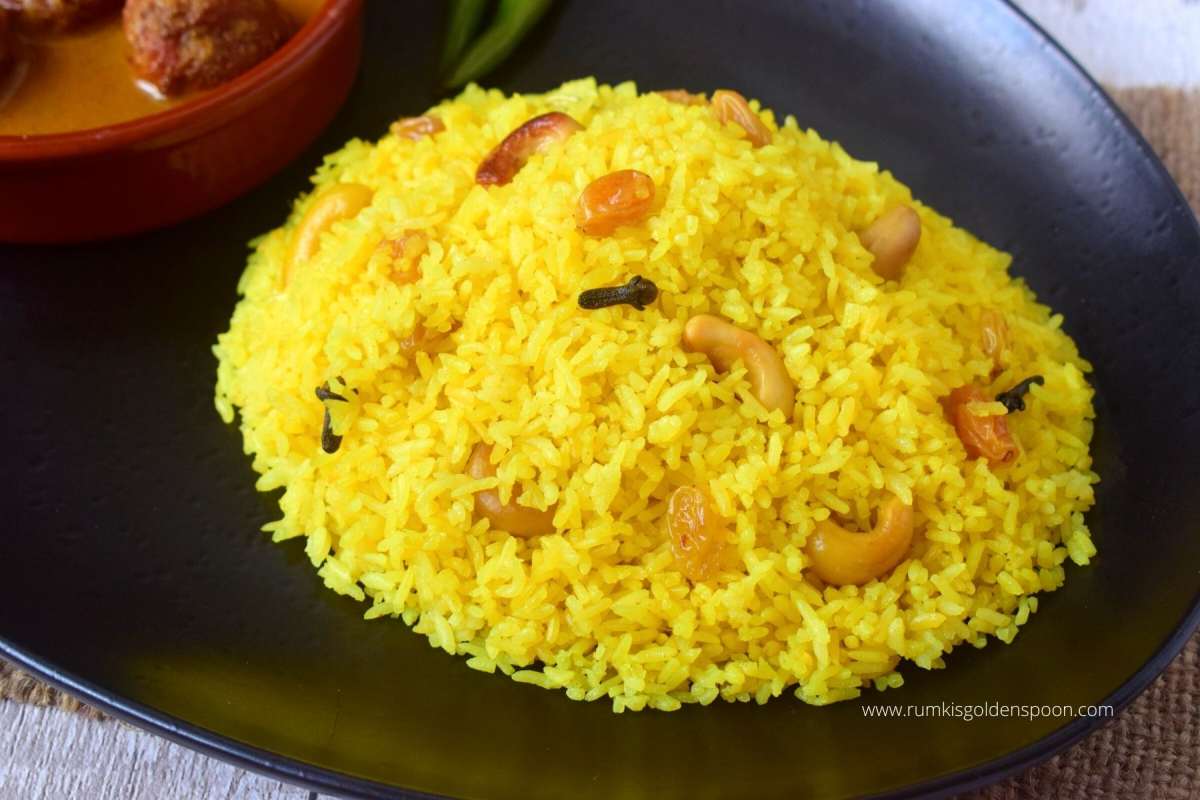
Table of Contents
About the recipe
Tips and Suggestions
Frequently Asked Questions
How to make Basanti Pulao (step wise photos)
Recipe Card
What is basanti pulao?
Basanti pulao the name itself explains the recipe. The word basanti means ‘Bright yellow colour’ and pulao means ‘fragrant rice recipe’. It is a traditional Bengali food that has been prepared in the Bengali kitchen for ages. It is mostly prepared on special occasions like marriage ceremonies, receptions, birthday parties etc. and even on festive days such as Durga puja recipe or Jagadhatri puja prasad.
Basically, basanti pulao recipe is a super-rich and aromatic ghee laden pulao recipe that is prepared with aged parboiled gobindo bhog rice in lots of ghee along with whole spices, raisins and cashew nuts. Hence, people devour it on special occasions. It is a sweet pulao recipe where sugar is added more as compared to salt. So, it is also known as mishti pulao. ‘Mishti’ is a Bengali word that means ‘sweet’.
Bengali mishti pulao is a delectable rice recipe that is loved by people of all age groups. Bengalis have an eternal love with the pulao recipe which has retained the recipe with matchless popularity for ages.
Reason behind the popularity of basanti pulao
- Firstly, its mesmerizing taste, flavour and texture which is enough to tickle anyone’s taste buds.
- It is easy to make and gets prepared quickly.
- It is prepared with limited ingredients which are easily available in any Indian kitchen pantry.
- It is a niramish recipe, I mean no onion no garlic recipe which is perfect for vegetarian days.
- In many places, it is also served as Bhog er Prasad in Puja festivals and is paired up with any veg side dish.
- It is served in Bengal on almost every special occasion like marriage ceremonies, annaprasans, birthday parties etc.
- In any reputed Bengali Restaurant, it is a ritual to have this asset Rice Dish in their Menu Card.
All in all, for a bong any festival or special occasion is incomplete without Basanti Pulao.
As a bong, I have grown up eating this delight and every time it totally engages me with its irresistible taste, unbeatable flavour and amazing texture. I have thousands of good memories with the traditional Bengali food and whenever I talk about it, I always feel nostalgic.
I don’t remember a single Durga puja when mom did not prepare basanti pulao since I got my senses. She learnt this delicacy from her mother (my Dida) and I have learnt it from my mom.
To prepare basanti pulao recipe, you would need core Bengali ingredients, including the specific rice variety named ‘Gobindobhog chaal’.
What is Gobindobhog chaal?
Gobindo Bhog Chaal (rice) is very famous in West Bengal. In Bengal, this rice is specially used in preparing Kheer and Pulao. It is very tiny grained aromatic white rice. It is mostly cultivated in a few districts of West Bengal.
Honestly, mishti pulao is an easy to make but a tricky recipe. It must be prepared using proper measurements of rice and water like any other pulao recipe. If the ratio for rice and water goes wrong, then the whole dish may collapse. And we all know a soggy pulao never tastes the same as a perfectly cooked fluffy pulao.
Basanti pulao recipe with step by step photos and instructions have been provided in the ‘Instructions’ section of the recipe. I have included all the tips and tricks to prepare perfect the Bengali mishti pulao. If you follow the steps precisely then you will get perfectly cooked and non-sticky pilaf. But before directly jumping into the recipe, let me share a few interesting facts about the Bengali veg recipe.
Tips to prepare perfect Basanti pulao
- Always use Gobindobhog rice (aromatic small grain rice) for the recipe. Don’t replace it with Basmati rice.
- Don’t replace the ghee with edible oil. Otherwise, the flavour and taste of the dish would dropdown.
- Don’t skip raisins and cashew nuts from the recipe. It provides both texture and flavour to the dish.
- Marinade the rice with ghee, spices and ginger paste and cover it for at least 1 hour for the perfect aroma.
- Fry the marinated rice thoroughly in ghee. The texture of the pulao partially depends on this step. As nicely as you fry them, the pulao will become perfect in texture.
- Don’t replace the whole spices with the ground spice mix. Whole spices give subtle flavour to the pulao without affecting its taste.
- Always use hot water to cook the basanti pulao recipe or else the pulao will become soggy.
- Add the measured amount of water in one batch and allow it to cook. Don’t add water slowly in batches.
- Follow the timeline to cook the pulao perfectly.
- After 10-15 minutes of cooking the mishti pulao, pour it into a large mixing bowl or else the pulao rice may stick to each other in the hot pan.
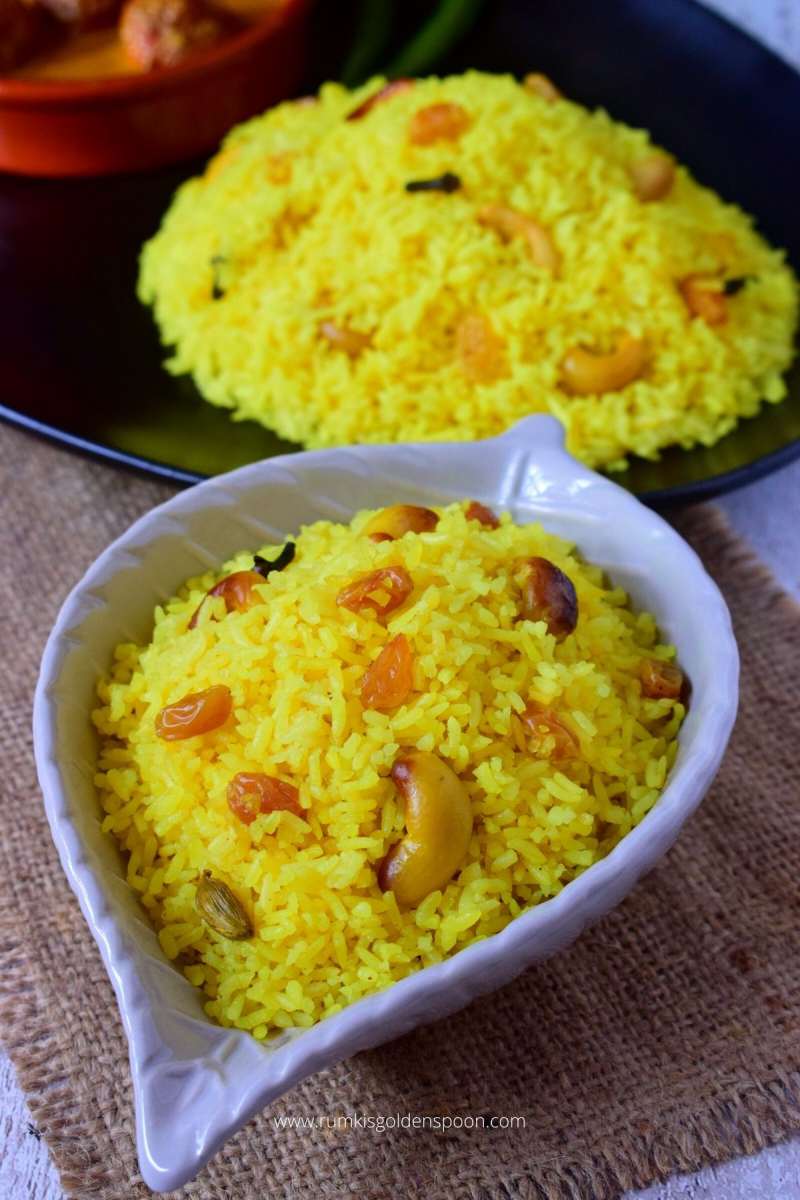
Ingredients for basanti pulao
Rice: A particular small grain fragrant rice variety of rice named gobindobhog chaal is used to cook the bengali pulao recipe. A good quality gobindobhog chaal fills the whole house with its fragrance during the time of cooking.
Ghee aka clarified butter: Basanti pulao is a ghee laden rice recipe where a generous amount of ghee is used to cook it. Here ghee is used in two parts to prepare the dish.
- To marinate the rice grains
- To fry the marinated rice evenly
Turmeric powder: It is used to get the bright yellow colour of the halud pulao.
Whole spices & ginger paste: Whole spices- cloves, cardamom, cinnamon sticks, bay leaves and ginger paste are used to marinate the washed and dried rice grain along with ghee. It helps to induce their flavour into the rice.
Even whole spices – bay leaves, cloves, cardamom, cinnamon sticks, black cardamom are used for tempering to make the ghee aromatic before cooking the pulao. In the traditional basanti pulao recipe, only whole spices are used to make the pulao aromatic. No ground spices are added to it except turmeric powder.
Dry fruits: In the traditional recipe, only raisins and cashew nuts are used. Both provide taste and flavour to the dish.
Green chillies: They provide a soothing and refreshing aroma to the pulao with a slight heaty touch.
Sugar and salt: Mishti pulao tastes more sweet than salty. So, sugar is added more as compared to salt. Both provide a balanced taste to the pulao.
Hot water: One of the most necessary ingredients which is added to cook the rice.
Frequently asked Questions
Can I make basanti pulao with basmati rice or other rice?
Yes, of course you can. But somehow you need to compromise in taste and flavour. Even you can try the recipe with other fragrant rice varieties like tulsi bhog chaal, Kamini bhog, kalijeera rice and chinigura rice. But the traditional basanti pulao is always prepared with aromatic gobindobhog chaal.
Can I use oil instead of ghee for the recipe?
Yes, you can. But the richness and fragrance of the dish will disappear due to the usage of edible oil. Nowadays many people mix oil and ghee together to make the pulao less rich.
Can I use food colour for the recipe?
Yes, you can. Even in many restaurants and catering services they regularly use yellow food colour in Basanti pulao.
But I personally don’t prefer to use food colour. Even in most of the Bengali households, any artificial food colour is hardly found. So, for the homemade version, Turmeric powder is used to colour the pulao.
Can I use saffron to colour the basanti pulao?
According to many people, the yellow colour of basanti pulao is inherited from Kesar aka saffron. But due to its high cost, normal people started using turmeric powder. But many people say turmeric powder is the ingredient that is used for colouring the pulao.
But according to me, saffron is well known more for its flavour than colour. If you like to add the flavour of saffron into this subtle delight, then you can add it.
Can I use ground spices instead of whole spices?
In traditional basanti pulao, no ground spices are used. Even I have used only whole spices to uplift the traditional touch. Other than these, the addition of ground spices may overpower the flavour of ghee and gobindobhog chal and make the pulao slightly bitter in taste.
Why my basanti pulao turned sticky?
There are multiple factors for which the pulao may turn sticky or soggy.
- The quality of gobindobhog rice. It should be aged not the new one. The new gobindobhog chaal gets sticky after cooking. So, it is suitable to prepare payesh not pulao.
- The measurement of water. Always double amount of water against that of rice is added to the pulao recipe.
- Use hot water during the time of preparing the pulao. If you add cold or room temperature water into the fried rice, then the pulao will turn sticky.
- Fry the marinated gobindobhog chaal thoroughly and evenly before adding hot water to cook the pulao.
What type of utensils are to be used to prepare the recipe?
Mishti pulao recipe is prepared in many ways in different types of utensils.
- Many people prepared it in Pressure Cooker.
- Many people use Dekchis to prepare it.
- Kadai or pan with lid can also be used to prepare it.
But personally, I recommend using non-stick Kadai with a lid to prepare this delicious delight.
How to make Basanti Pulao?
To prepare the basanti pulao first, wash the gobindobhog rice (small grain rice) and strain the water completely. Keep it aside for air drying.
Then transfer the dried gobindobhog rice into a large bowl. Then add whole spices – cloves, cardamom, cinnamon sticks, bay leaves, ginger paste, turmeric powder and ghee, one by one into the rice and mix it evenly with your hand. Then cover the pan with a plate or cling film and keep it aside for at least 1 hour.
After 1 hour, put a pan on flame and add ghee into it. Fry the cashew nuts till golden and raisins until they plump up and keep them aside on a separate plate.
Then add the whole spices – cinnamon stick, cloves, cardamoms, back cardamom and bay leaves for tempering and let them crackle.
Add the marinated rice into the pan and fry it on a medium flame for 7-8 minutes until the rice becomes opaque and a sound comes during the time of stirring. Stir the mixture continuously. This step takes some time to get the rice and dal fried properly but you need to be patient at this point.
Add hot water into the pan. Add the fried cashew nuts, raisins, salt and sugar, one by one into the pan and give a gentle stir. Cover the pan and cook it over medium flame for 5-6 minutes till the rice becomes visible.
Add green chillies and again close the lid of the pan. Cook it for another 10 minutes on the lowest flame. Then switch off the flame and don’t disturb the pan for another 15 minutes.
Then pour the basanti pulao into a large mixing bowl or else they may stick to each other in the hot pan.
Many bengali veg recipes have already been shared in my previous posts. You can check a few of them like
Bhoger khichuri
Bhuni khichuri
Chanar dalna
Niramish aloor dum
..And Many more…
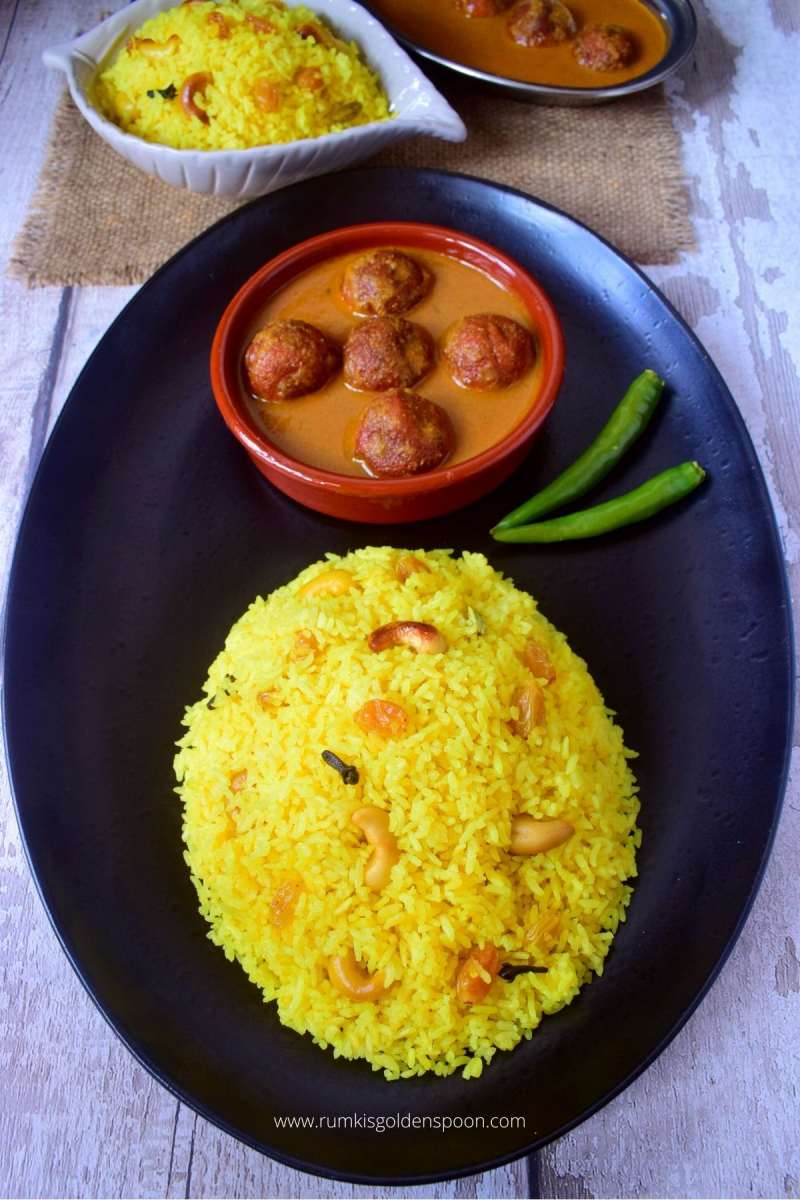
Ingredients:
1 cup = 250 ml
To marinate the rice
- 1½ cup Gobindobhog Chaal (small grain rice)
- 1 tablespoon Ginger paste
- 3 Cloves (Laung)
- 3 Cardamoms (Elaichi)
- 2 inches Cinnamon stick (Dalchini)
- 1 Bay leaf (Tejpatta)
- 1 teaspoon Turmeric powder
- 2 tablespoons Ghee (Clarified butter)
Other ingredients for basanti pulao
- 2 tablespoons Cashew nuts
- 2 tablespoons Raisins
- 2 green Chillies
- 3 Cloves (Laung)
- 3 Cardamoms (Elaichi)
- 1 Black Cardamom (Badi elaichi)
- 1-inch Cinnamon stick (Dalchini)
- 1 Bay leaf (Tejpatta)
- 3 tablespoons Sugar (Adjust accordingly)
- 1½ teaspoons Salt (Adjust accordingly)
- 1½ tablespoons Ghee (Clarified butter)
- 3 cups Hot water
Instructions:
- First, wash 1½ cups Gobindobhog chaal 3-4 times until the water gets clear. Then strain the excess water with a strainer and keep it aside to get air dried.
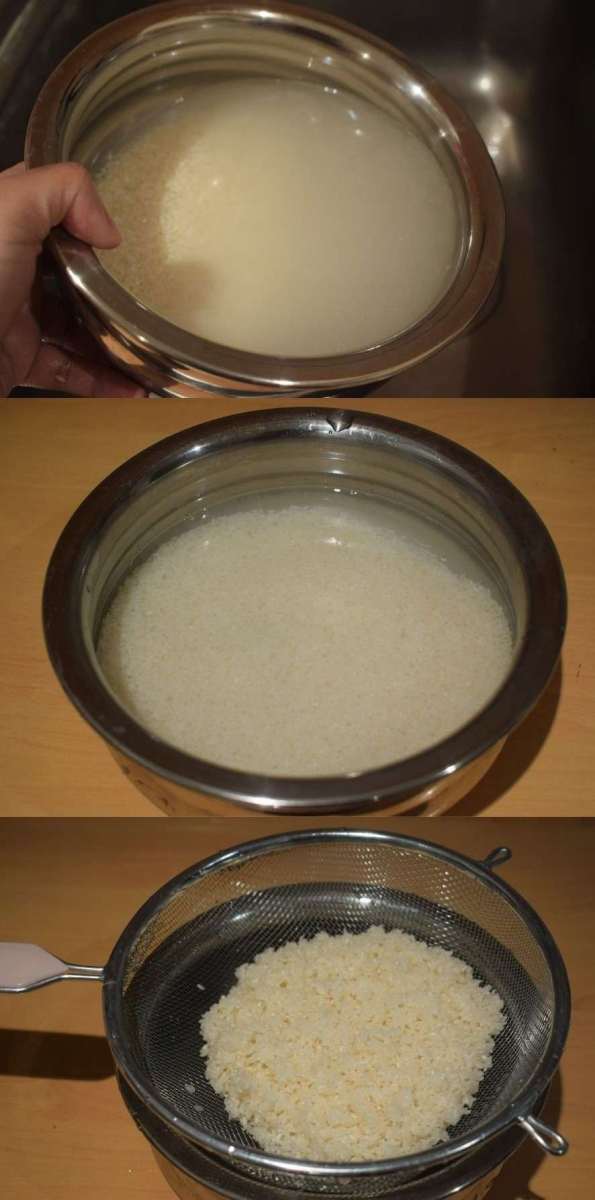
- Transfer the dried gobindobhog rice into a large bowl. Then add whole spices – 3 cloves, 3 cardamoms,2 inches cinnamon sticks, 1 bay leaves, 1 tablespoon ginger paste, 1 teaspoon turmeric powder and 2 tablespoons ghee, one by one into the rice and mix it evenly with hand.
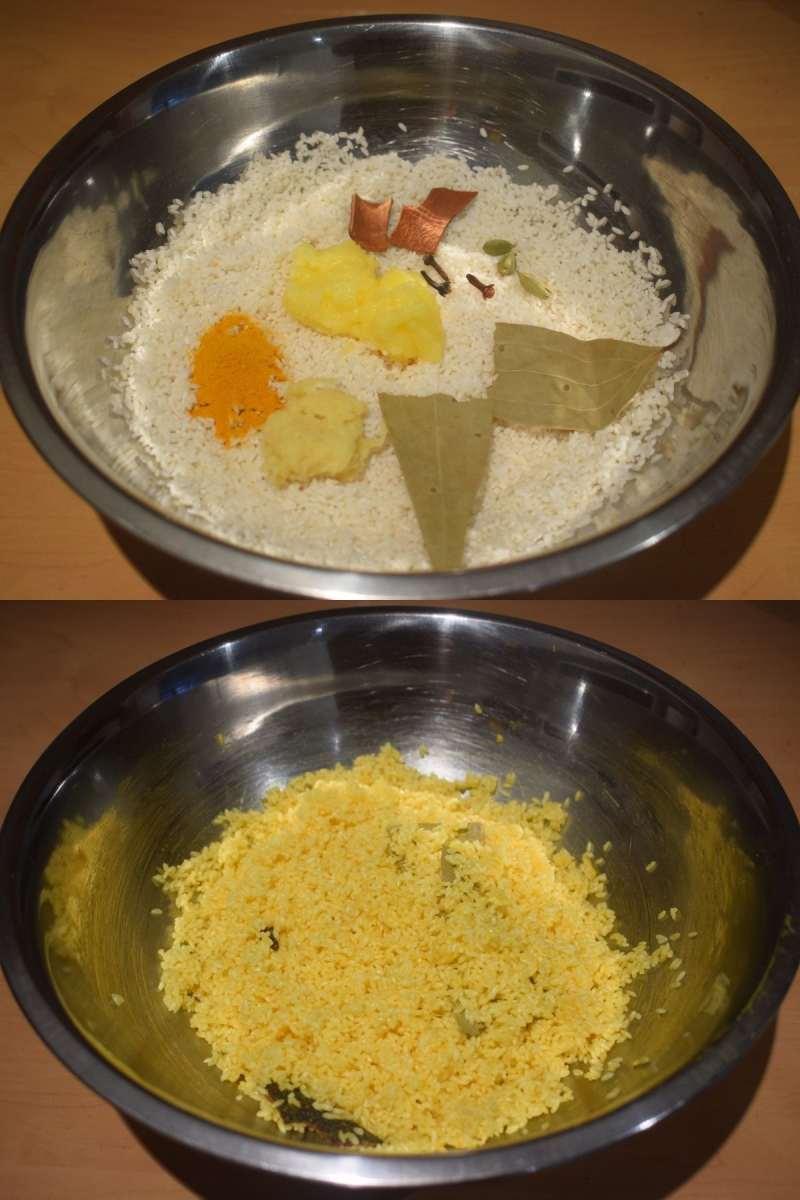
- Cover the pan with a plate or cling film and keep it aside for at least 1 hour.
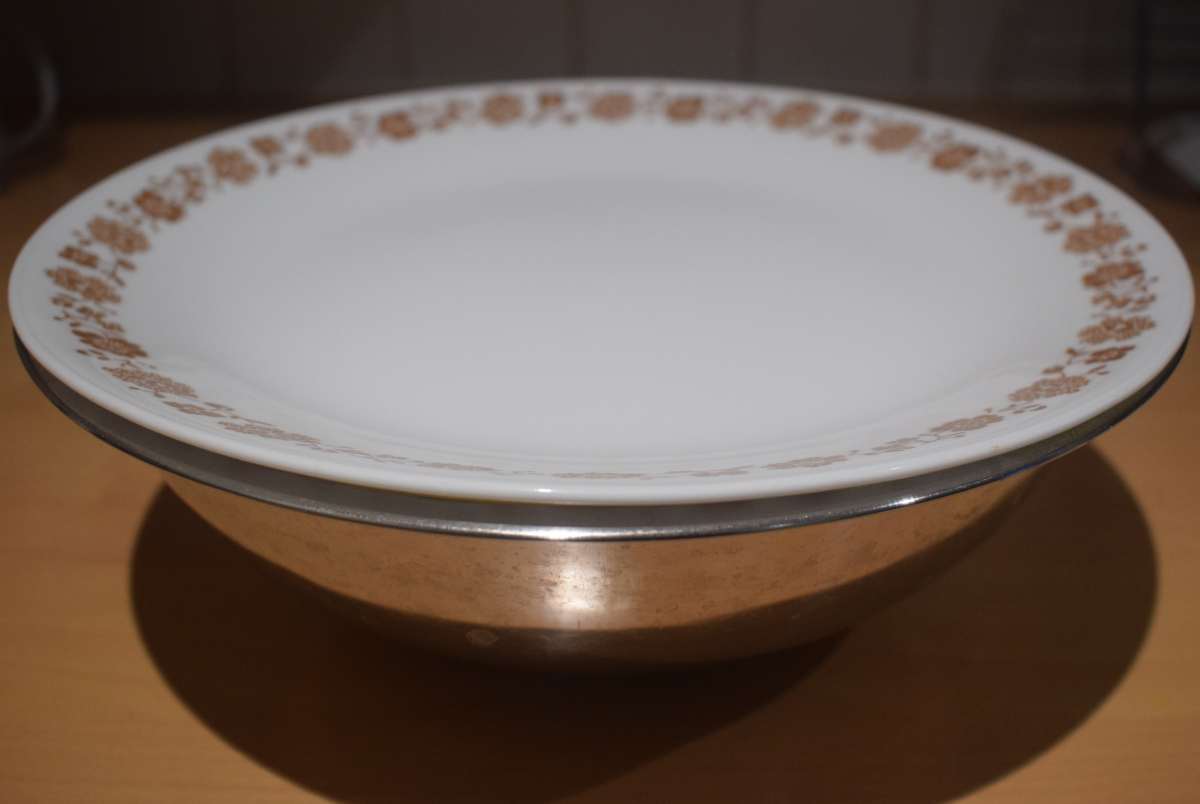
- After 1 hour, put a pan on flame and add 1½ tablespoons ghee into it.

- Once the ghee is hot, add cashew nuts into it and fry them till golden. Keep the cashews on a separate plate.
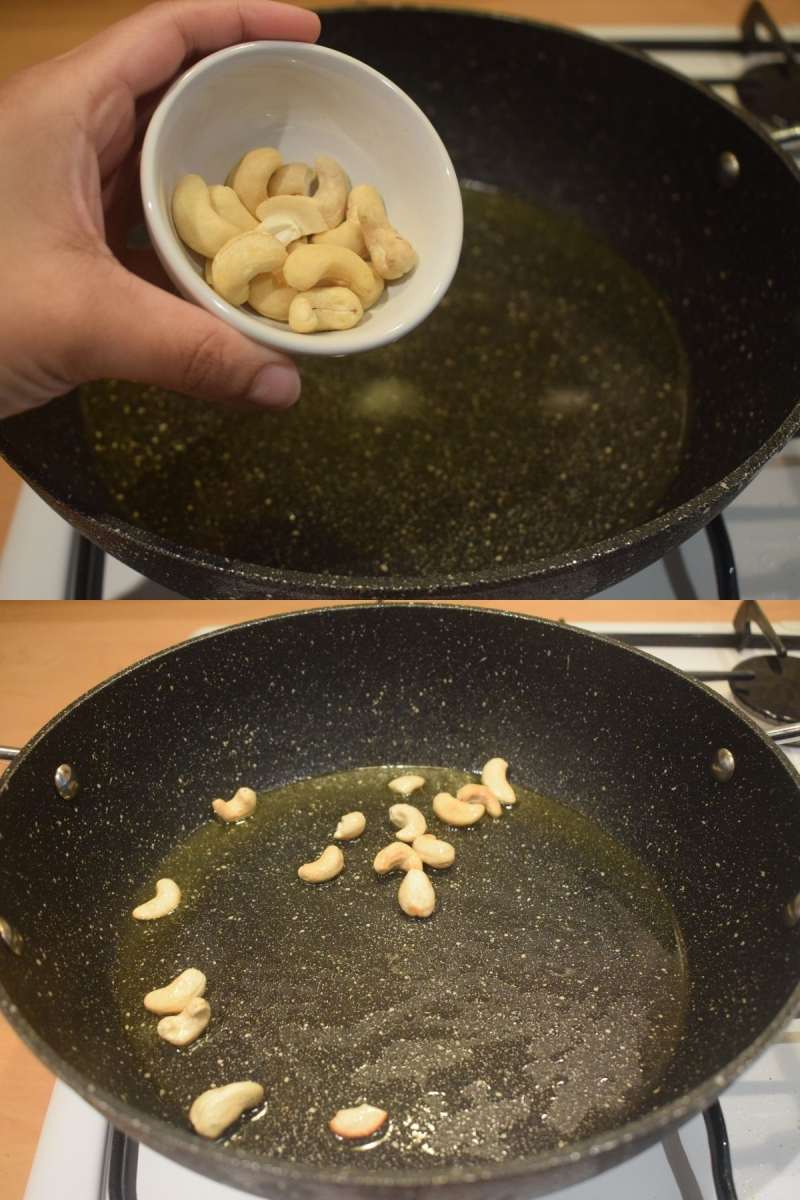
- Add raisins into the pan and fry them till they plump up. Keep them aside on a separate plate.
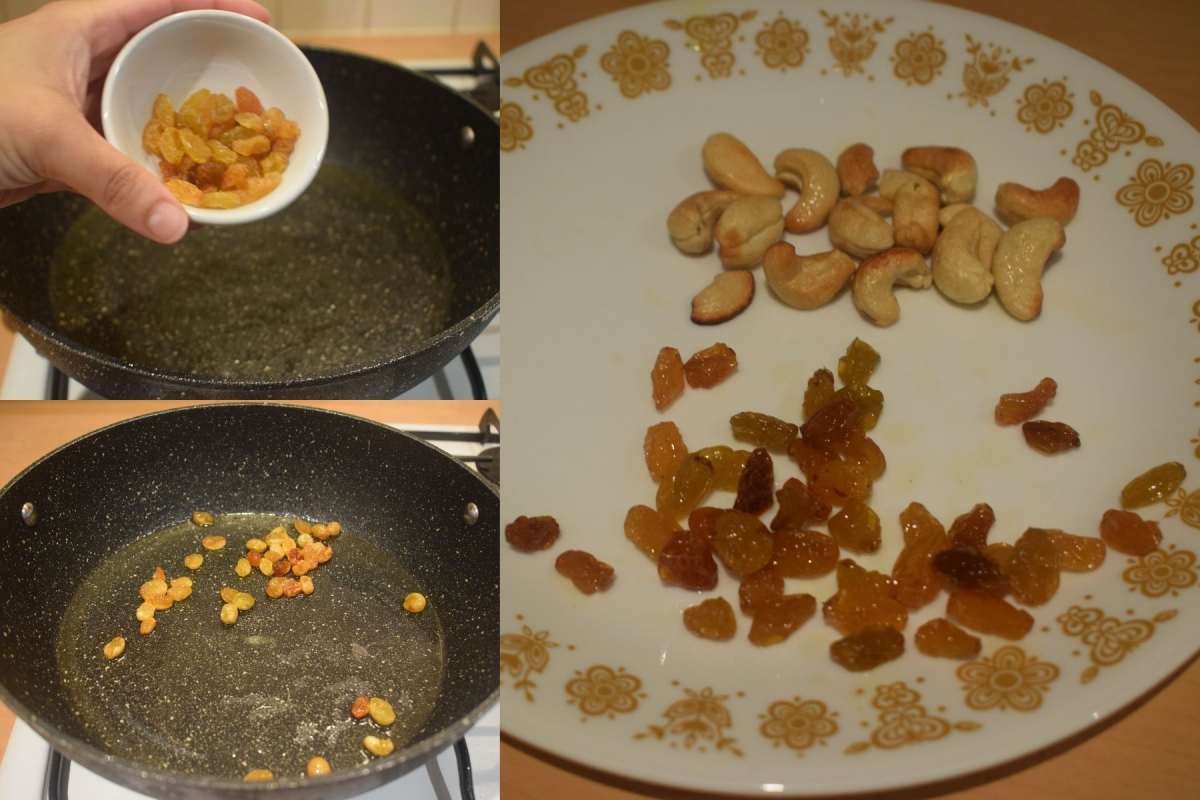
- Add the whole spices – 1-inch cinnamon stick, 3 cloves, 3 cardamoms, 1 back cardamom and 1 bay leaves for tempering and let them crackle.
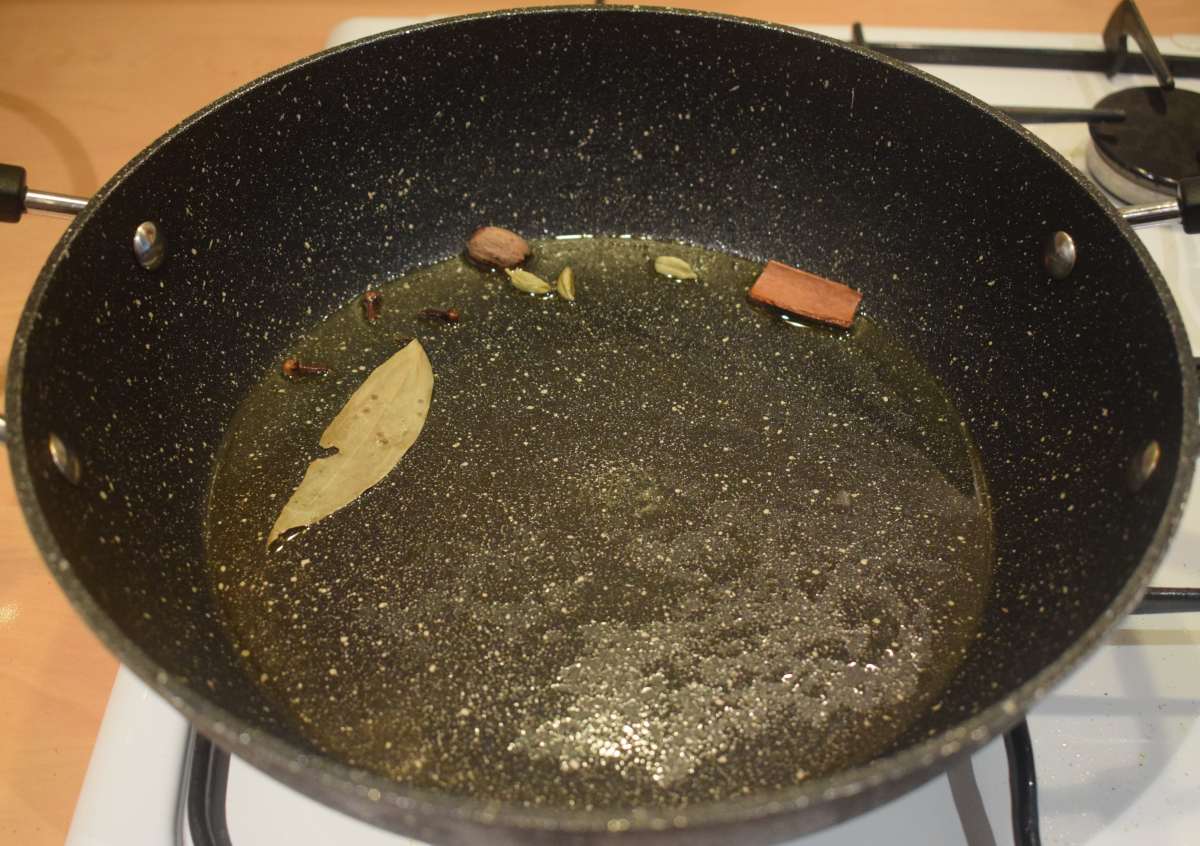
- Add the marinated rice (Step 2) into the pan and fry it on a medium flame for 7-8 minutes until the rice becomes opaque and a sound comes during the time of stirring. Stir the mixture continuously. This step takes some time to get the rice fried properly but you need to be patient at this point.
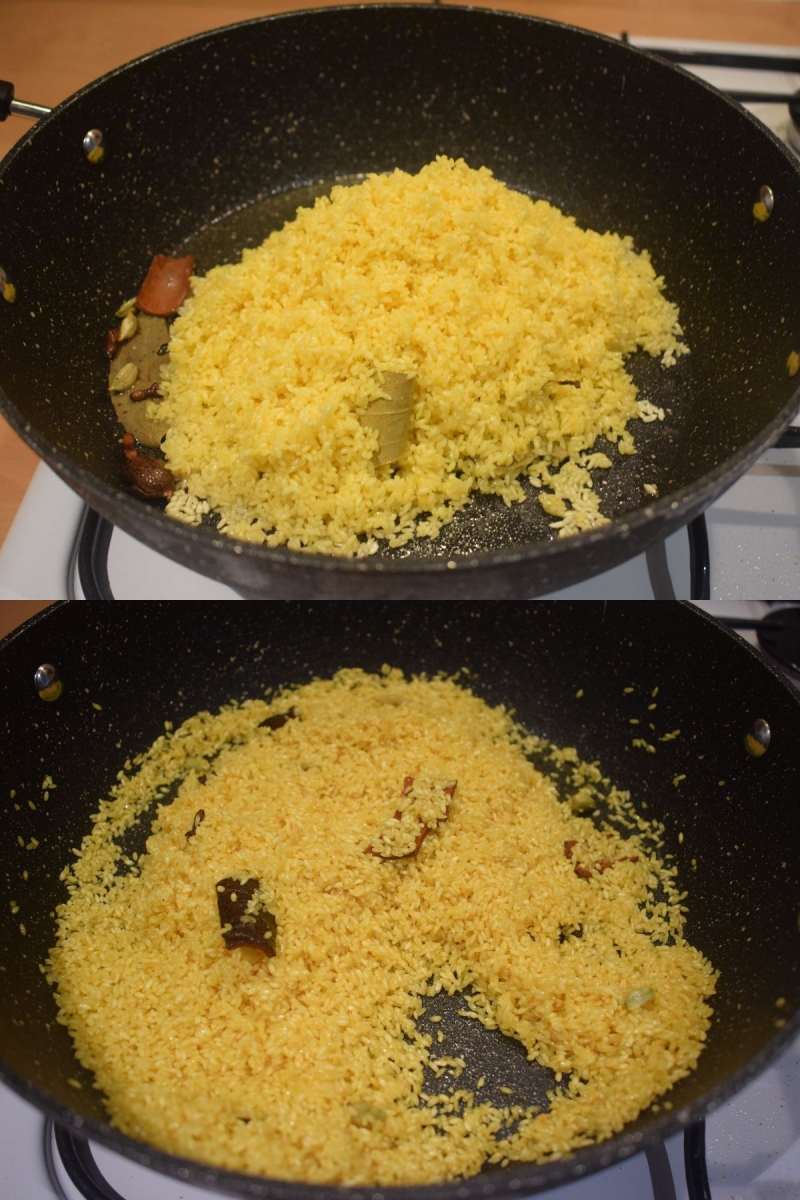
- Add 3 cups hot water, the fried cashew nuts, raisins, 1½ teaspoons salt and 3 tablespoons sugar, one by one into the pan and give a gentle stir. Cover the pan and cook it over medium flame for 5-6 minutes till the rice becomes visible.
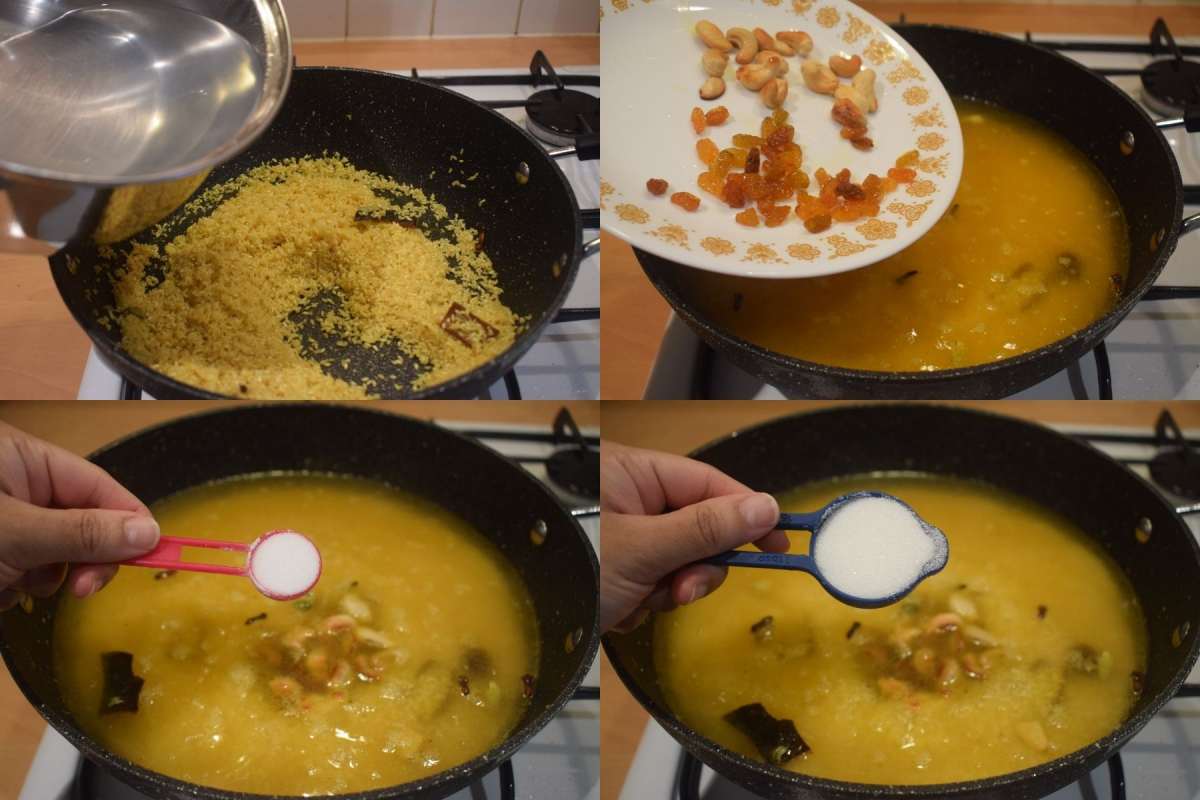
- Add 2 green chillies and again close the lid of the pan. Cook it for another 10 minutes on the lowest flame.
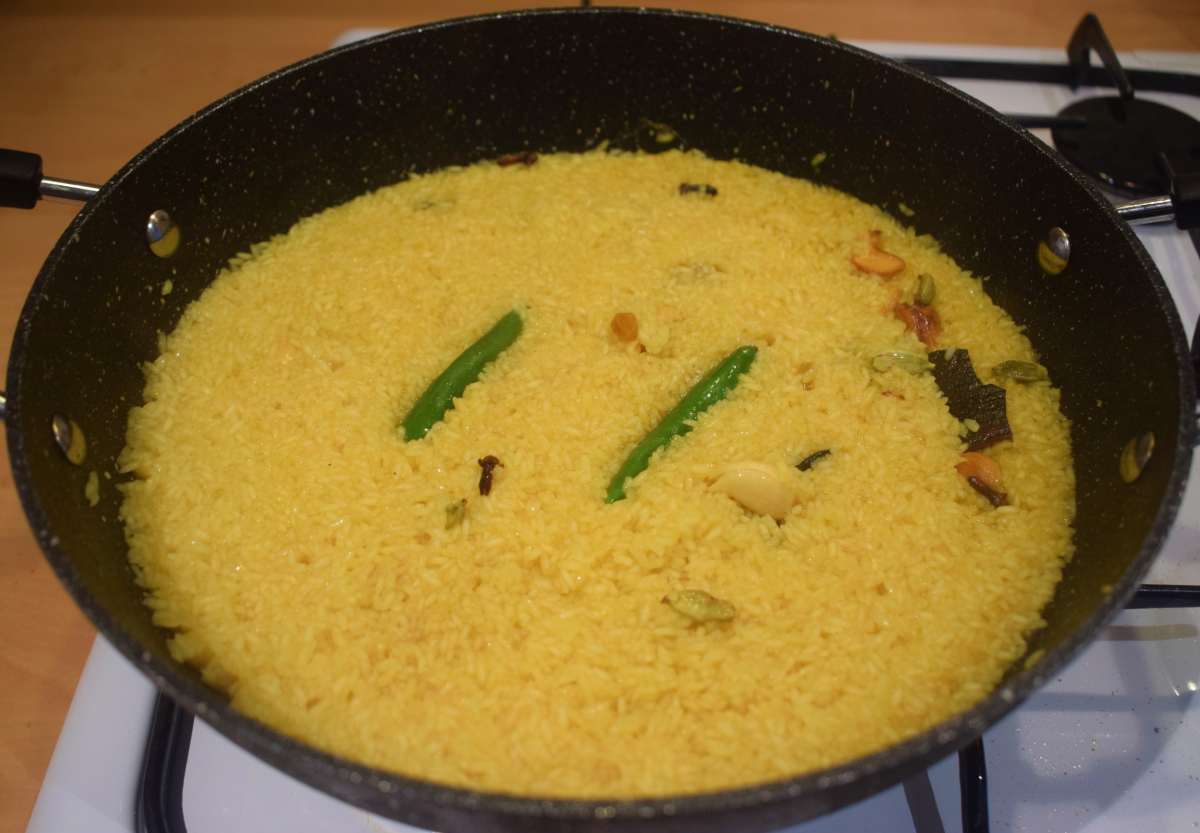
- Switch off the flame and but don’t disturb the pan for another 15 minutes.
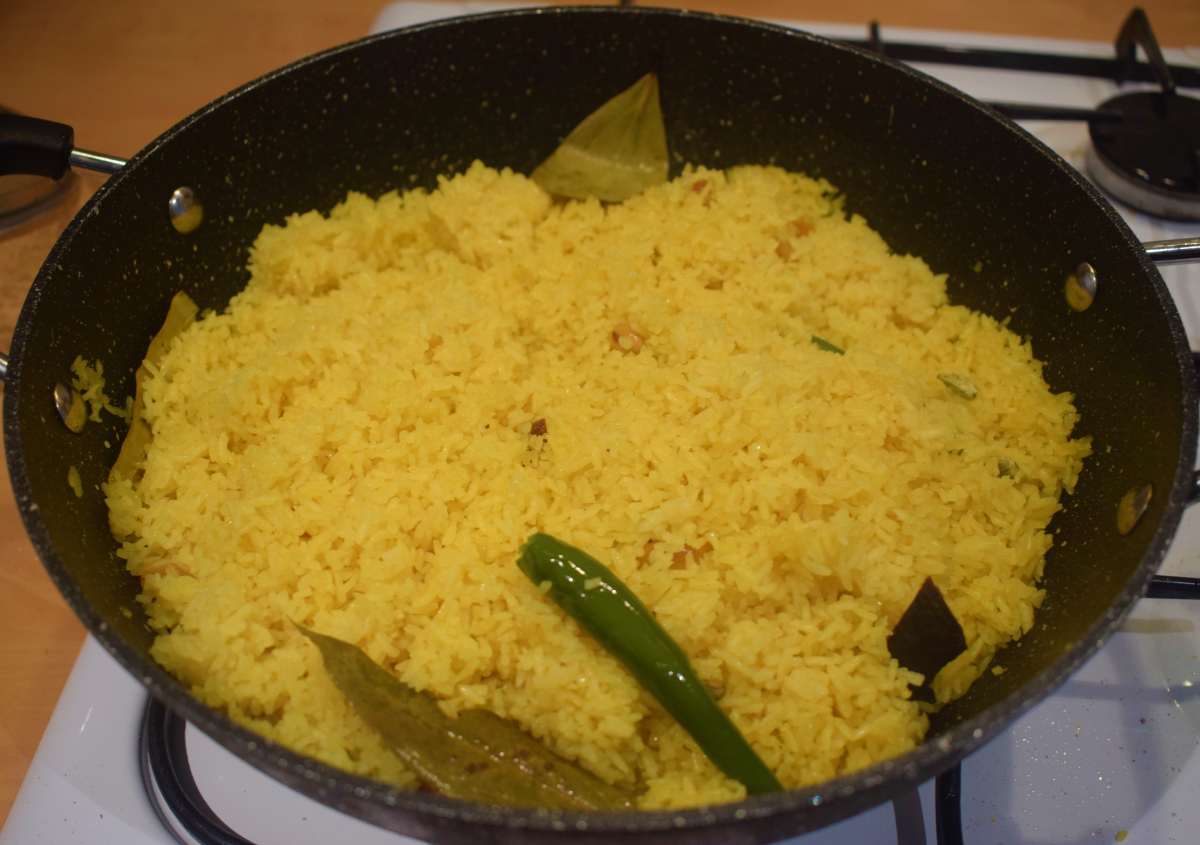
- Pour the basanti pulao into a large mixing bowl or else they may stick to each other in the hot pan.
Serving Instruction
Serve the basanti pulao aka mishti pulao on serving plates. It tastes better after 2-3 hours of cooking than immediate serving. The flavours get absorbed into the rice and rice become fluffier. So, plan and execute accordingly. Pair up the authentic dish with kosha mangsho, niramish alur dom or chanar dalna and enjoy the eternal taste of Bengali food.
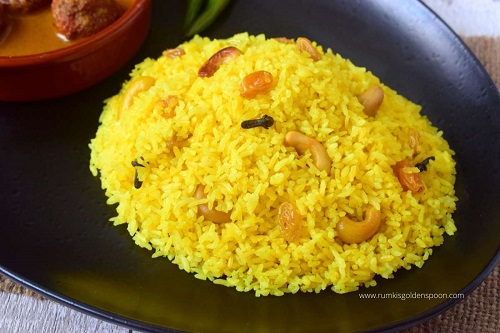
Ingredients
1 cup = 250 ml To marinate the rice
- 1½ cup Gobindobhog Chaal (small grain rice)
- 1 tablespoon Ginger paste
- 3 Cloves (Laung)
- 3 Cardamoms (Elaichi)
- 2 inches Cinnamon stick (Dalchini)
- 1 Bay leaf (Tejpatta)
- 1 teaspoon Turmeric powder
- 2 tablespoons Ghee (Clarified butter)
Other ingredients for basanti pulao
- 2 tablespoons Cashew nuts
- 2 tablespoons Raisins
- 2 green Chillies
- 3 Cloves (Laung)
- 3 Cardamoms (Elaichi)
- 1 Black Cardamom (Badi elaichi)
- 1-inch Cinnamon stick (Dalchini)
- 1 Bay leaf (Tejpatta)
- 3 tablespoons Sugar (Adjust accordingly)
- 1½ teaspoons Salt (Adjust accordingly)
- 1½ tablespoons Ghee (Clarified butter)
- 3 cups Hot water
Instructions
- First, wash 1½ cups Gobindobhog chaal 3-4 times until the water gets clear. Then strain the excess water with a strainer and keep it aside to get air dried.
- Transfer the dried gobindobhog rice into a large bowl. Then add whole spices – 3 cloves, 3 cardamoms, 2 inches cinnamon sticks, 1 bay leaves, 1 tablespoon ginger paste, 1 teaspoon turmeric powder and 2 tablespoons ghee, one by one into the rice and mix it evenly with hand.
- Cover the pan with a plate or cling film and keep it aside for at least 1 hour.
- After 1 hour, put a pan on flame and add 1½ tablespoons ghee into it.
- Once the ghee is hot, add cashew nuts into it and fry them till golden. Keep the cashews on a separate plate.
- Add raisins into the pan and fry them till they plump up. Keep them aside on a separate plate.
- Add the whole spices – 1-inch cinnamon stick, 3 cloves, 3 cardamoms, 1 back cardamom and 1 bay leaves for tempering and let them crackle.
- Add the marinated rice (Step 2) into the pan and fry it on a medium flame for 7-8 minutes until the rice becomes opaque and a sound comes during the time of stirring. Stir the mixture continuously. This step takes some time to get the rice fried properly but you need to be patient at this point.
- Add 3 cups hot water, the fried cashew nuts, raisins, 1½ teaspoons salt and 3 tablespoons sugar, one by one into the pan and give a gentle stir. Cover the pan and cook it over medium flame for 5-6 minutes till the rice becomes visible.
- Add 2 green chillies and again close the lid of the pan. Cook it for another 10 minutes on the lowest flame.
- Switch off the flame and but don’t disturb the pan for another 15 minutes.
- Pour the basanti pulao into a large mixing bowl or else they may stick to each other in the hot pan.
KITCHEN TOOLS for the recipe:
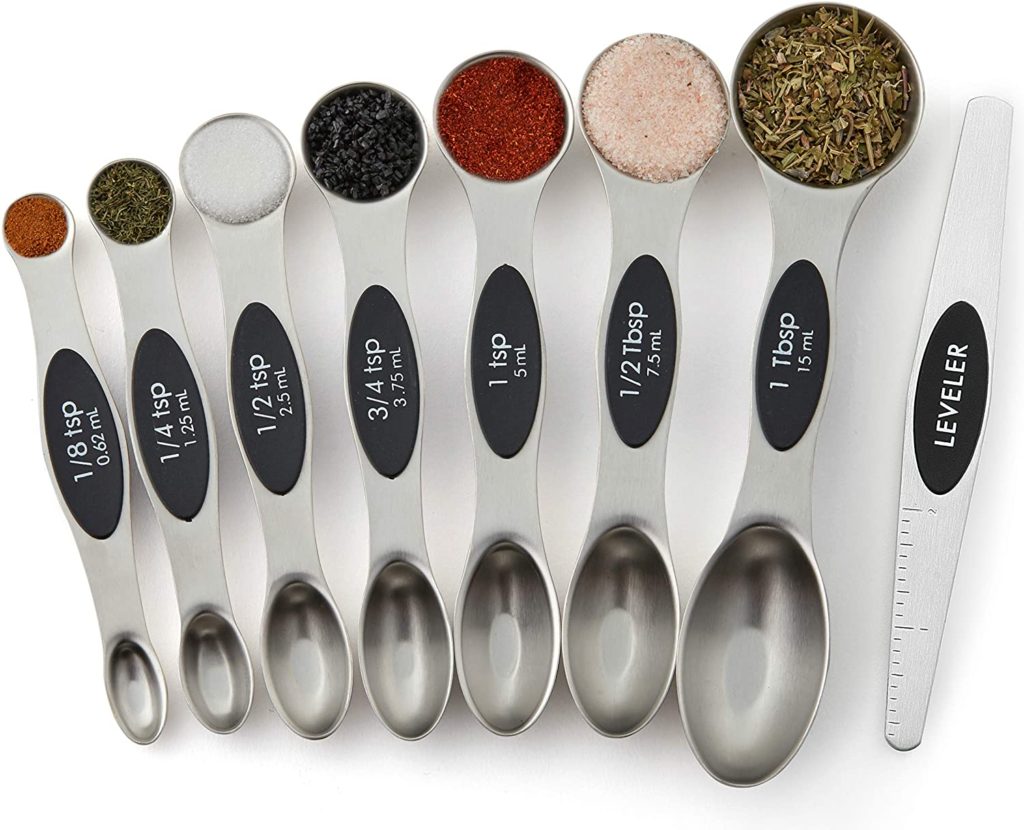
Measuring Spoons

Measuring Cups
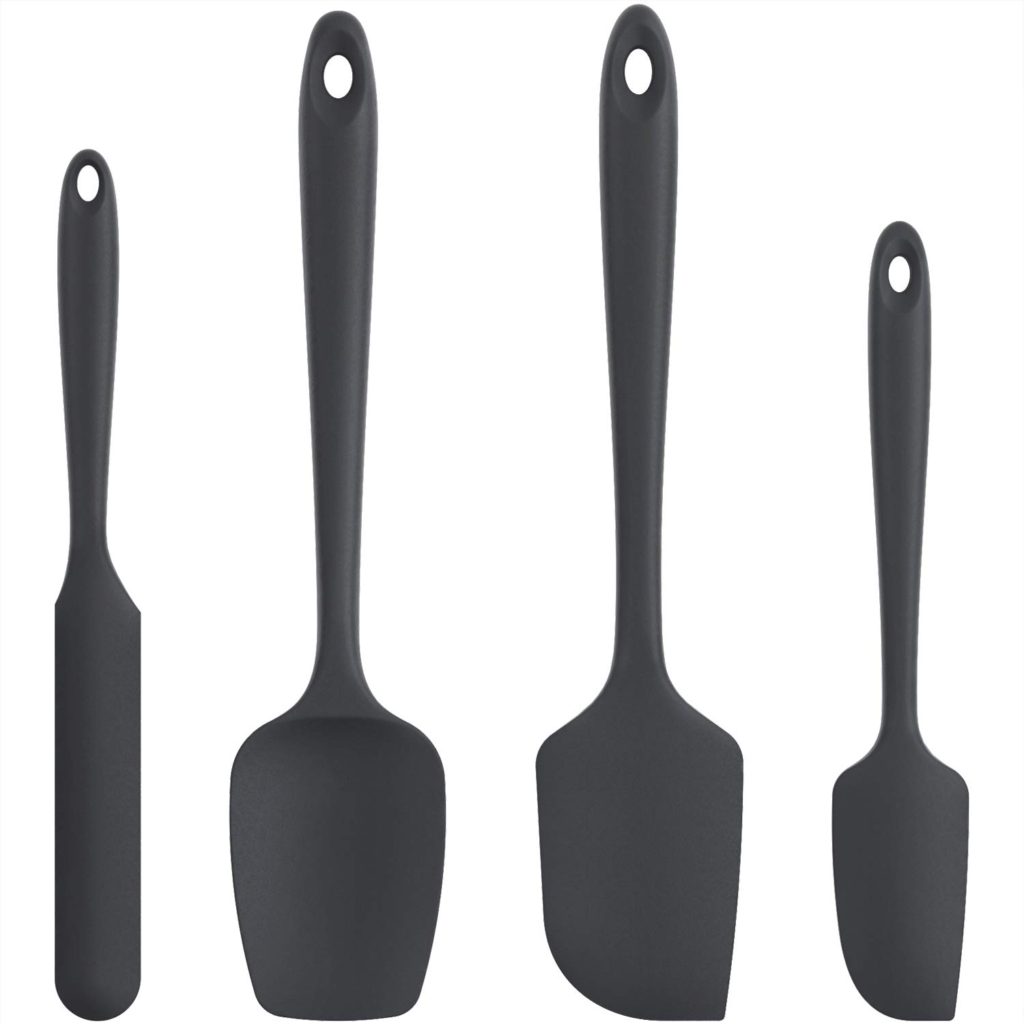

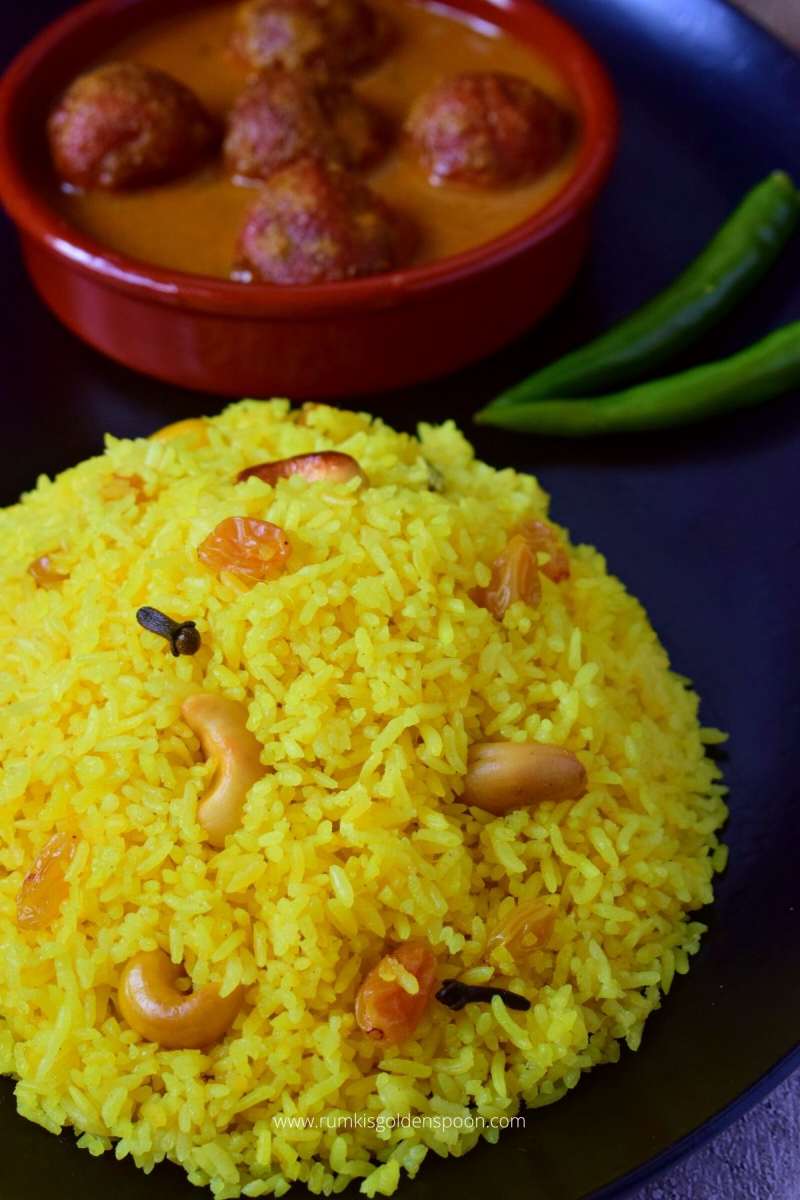
4 comments
[…] the luscious Bengali dish. So, one day during Durga puja, I decided to prepare Dhoka’r dalna and basanti pulao on my own. Then I called up my mom and noted down the recipe. To be honest, on my first attempt the […]
[…] 1. Basanti pulao Basanti pulao recipe aka mishti pulao is an exemplary and inimitable pulao rice recipe of Bengal which is frequently prepared on special occasions and festive seasons. It is crazily popular among Bengalis and has occupied a place on almost every reputed restaurant’s menu card. Basanti pulao is a subtle bright yellow coloured sweet and fragrant pulao recipe prepared with a special rice grain named ‘Gobindo bhog chaal’. In this preparation, the aromatic rice grain is cooked with whole spices, turmeric powder, ginger, a generous amount of ghee along with sugar, salt, raisins and cashew nuts. It is also known as halud pulao because of its bright yellow colour. This slobbering dish is mostly relished with spicy curries to balance the sweetness of the dish. […]
[…] it during the festive season. She used to serve it mostly as a side with phulko luchi or with basanti pulao and we used to devour that with eternal pleasure. I have learned this Bengali veg recipe from […]
[…] Chingri macher malai curry aka chingri malaikari is an exemplary fish curry recipe which is crazily popular among Bengalis. It is renowned for its inimitable taste, texture and flavour. In this preparation, large tiger prawns (bagda chingri or golda chingri) are cooked in coconut milk with onion, tomato and a few fragrant Bengali spices. This luscious Bengali fish curry frequently appears on special occasions like marriage reception party (biye bari), annaprashan etc. Other than that, prawn malai curry recipe has occupied top places in reputed Bengali restaurants’ menu cards all over the world. It is mostly relished with steamed basmati rice but you can also pair up it with Bengali mishti pulao. […]